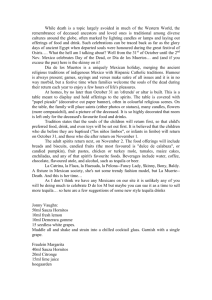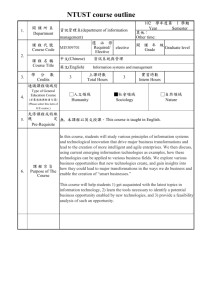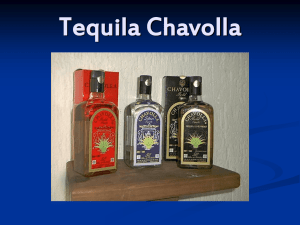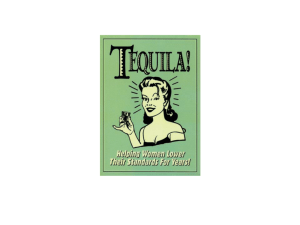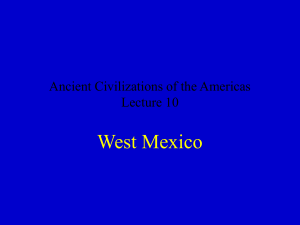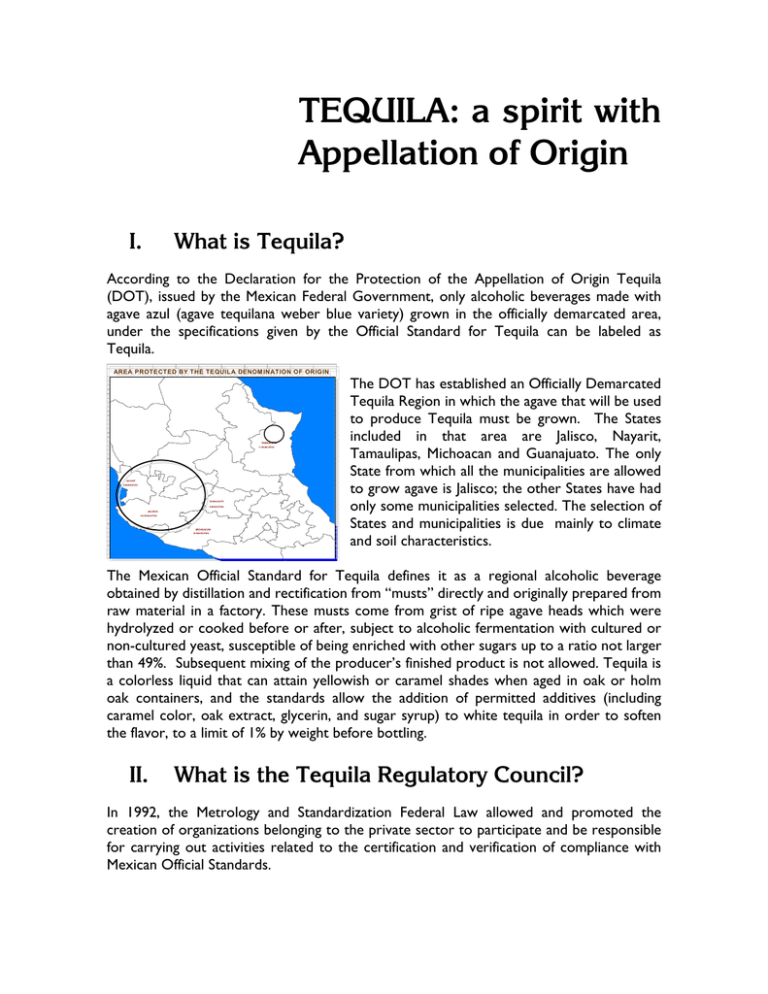
TEQUILA: a spirit with
Appellation of Origin
I.
What is Tequila?
According to the Declaration for the Protection of the Appellation of Origin Tequila
(DOT), issued by the Mexican Federal Government, only alcoholic beverages made with
agave azul (agave tequilana weber blue variety) grown in the officially demarcated area,
under the specifications given by the Official Standard for Tequila can be labeled as
Tequila.
AREA
AREAPROTECTED
PROTECTEDBY
BYTHE
THETEQUILA
TEQUILADENOM
DENOMINATION
INATIONOF
OFORIG
ORIGIN
IN
TAMAULIPAS
TAMAULIPAS
11 MUNICIPIOS
11 MUNICIPIOS
NAYARIT
NAYARIT
8 MUNICIPIOS
8 MUNICIPIOS
JALISCO
JALISCO
GUANAJUATO
GUANAJUATO
6 MUNICIPIOS
6 MUNICIPIOS
124 MUNICIPIOS
124 MUNICIPIOS
MICHOACÁN
MICHOACÁN
29 MUNICIPIOS
29 MUNICIPIOS
The DOT has established an Officially Demarcated
Tequila Region in which the agave that will be used
to produce Tequila must be grown. The States
included in that area are Jalisco, Nayarit,
Tamaulipas, Michoacan and Guanajuato. The only
State from which all the municipalities are allowed
to grow agave is Jalisco; the other States have had
only some municipalities selected. The selection of
States and municipalities is due mainly to climate
and soil characteristics.
The Mexican Official Standard for Tequila defines it as a regional alcoholic beverage
obtained by distillation and rectification from “musts” directly and originally prepared from
raw material in a factory. These musts come from grist of ripe agave heads which were
hydrolyzed or cooked before or after, subject to alcoholic fermentation with cultured or
non-cultured yeast, susceptible of being enriched with other sugars up to a ratio not larger
than 49%. Subsequent mixing of the producer’s finished product is not allowed. Tequila is
a colorless liquid that can attain yellowish or caramel shades when aged in oak or holm
oak containers, and the standards allow the addition of permitted additives (including
caramel color, oak extract, glycerin, and sugar syrup) to white tequila in order to soften
the flavor, to a limit of 1% by weight before bottling.
II.
What is the Tequila Regulatory Council?
In 1992, the Metrology and Standardization Federal Law allowed and promoted the
creation of organizations belonging to the private sector to participate and be responsible
for carrying out activities related to the certification and verification of compliance with
Mexican Official Standards.
Accordingly, the Tequila Regulatory Council or Consejo Regulador del Tequila (CRT) was
created in Guadalajara, Jalisco, Mexico, in 1994; the year in which it was accredited by the
General Direction of Standards of the Secretary of Economy to become the organization
charged with certifying conformity to the Mexican Official Standard of Tequila (NOM-006SCFI-1994). A year later, the CRT was also accredited as the official verification unit.
The CRT is a private non-profit organization with a worldwide scope that renders
impartial decisions as to whether or not a product complies with the Standards.
Moreover, the CRT is the only private organization accredited by the Federal Mexican
Government to evaluate the conformity to the Official Standard of Tequila by performing
verification and certification activities.
The CRT’s maximum authority is the Board of Associates, in which all the groups involved
in the Tequila industry are represented in sections. Accordingly, “Section A” represents
the Tequila Producers, “Section B” represents the Agave Producers, “Section C”
represents the Bottlers and Marketers, and finally, “Section D” is composed by
representatives of the Mexican Government, specifically, the Secretary of Economy, the
Mexican Institute of Industrial Property, the Federal Consumer Protection Agency, the
Secretary of Health and the Secretary of Agriculture and Natural Resources.
100
91
80
56
60
40
41
36
27
20
0
69 67
61
39
97
94
70
73
Tequila Producers
Agave Producers
47
Bottlers and Marketers
5 36
6 86
7 96
796
8106
1994
1995
1996
1997
1998
8106
8106
1999
2000
Government
Total Members
Since its creation, the CRT’s main objectives have been:
•
•
•
•
To ensure the compliance with the Official Standard of Tequila by all the
producers, bottlers and marketers though verification and certification procedures;
To guarantee the purity of Tequila to the consumer;
To safeguard the appellation of origin in Mexico and throughout the world; and,
To provide accurate and timely information to the Agave-Tequila supply chain.
2
III. What is a geographical indication?
The World Intellectual Property Organization (WIPO) defines a geographical indication as
“a sign used on goods that have a specific geographical origin and possess qualities or a
reputation that are due to that place of origin.” Most commonly, a geographical indication
consists of the name of the place of origin of the goods. Agricultural products typically
have qualities that derive from their place of production and are influenced by specific
local factors, such as climate and soil. Whether a sign functions as a geographical indication
is a matter of national law and consumer perception.
Although geographical indications are usually employed in
connection with agricultural products like Tuscany for olive oil,
Dijon for mustard or Roquefort for cheese, their use is not
limited to them.
Geographical indications may also highlight specific qualities of a
product which are due to human factors that can be found in the
place of origin of the products, such as specific manufacturing
skills and traditions.
Geographical indications are understood by consumers to denote the origin and quality of
their products. Many of them have acquired valuable reputations, which if not adequately
protected, may be misrepresented by dishonest commercial operators. False use of
geographical indications by unauthorized parties is detrimental to consumers and
legitimate producers.
IV. What is an appellation of origin?
The WIPO defines an appellation of origin as “a special kind of
geographical indication, used on products that have a specific quality
that is exclusively or essentially due to the geographical environment in
which the products are made.” The concept of geographical indication
encompasses appellations of origin.
V.
What is the role of Standards?
Standards are necessary to enable the government to guarantee the
quality of a product covered by an appellation of origin.
The Standards also serve as important reference sources for domestic as well as
international trade. Their main goal is to unify the parameters on which products or
services are created or given. This translates into better consumer protection by
enhancing product quality and eliminating inferior products. In the specific case of Tequila,
the standards also ensure a stronger protection of the appellation of origin.
3
Authorities involved in regulating and controlling the product or service, and industry
stakeholders, both participate in drafting every Standard; the final version is published in
the Official Federal Journal (Diario Oficial de la Federación).
VI. What is the Mexican Official Standard for
Tequila?
The Mexican Official Standard for Tequila is NOM-006-SCFI-1994, Bebidas alcohólicasTequila-Especificaciones (NOM), published in September 1997. The Standard has been
amended only once, on March 1st, 2000, to lower the minimum proof from 76 to 70
proof.
The goal of this Standard is to establish the characteristics and specifications that every
authorized producer must comply with in order to produce, bottle and/or market Tequila.
A set of rules for each and every step is provided.
The main provisions of NOM-006-SFI-1994, can be summarized as follows:
•
A comprehensive set of definitions related to the different types of Tequila. What
must be considered as Tequila silver, gold, aged and extra-aged, as well as carefully
defined methods to obtain these qualities.
•
The specific characteristics of the agave intended to be used in the production of
Tequila are set forth.
•
The classification between Tequila 100% Agave, made from 100% agave sap, and
Tequila, a category produced with 51% of agave sap and up to 49% other sugars.
TEQUILA100%
100%AGAVE
AGAVE
TEQUILA
HITEOR
ORSILVER
SILVER
WW
HITE
YOUNGOR
ORGOLD
GOLD
YOUNG
AGEDoror"Repo"
"Repo"
AGED
ATLEAST
LEAST2 2MONTHS
MONTHS
AT
TEQUILA
TEQUILA
EXTRA-AGEDoror"Añejo"
"Añejo"
EXTRA-AGED
ONEYEAR
YEARININCASKS
CASKS
ONE
HITEOR
ORSILVER
SILVER
WW
HITE
YOUNGOR
ORGOLD
GOLD
YOUNG
AGEDoror"Repo"
"Repo"
AGED
AT LEAST 2 MONTHS
AT LEAST 2 MONTHS
EXTRA-AGEDoror"Añejo"
"Añejo"
EXTRA-AGED
ONE YEAR IN CASKS
ONE YEAR IN CASKS
•
Tequila 100% Agave is not allowed to be exported in bulk, which means that it
must be bottled on the premises of the factory within the officially demarcated
region of the appellation of origin. On the other hand, Tequila can be exported by
bulk and bottled in other countries, provided there is a co-responsibility contract
between the manufacturer and the bottler to provide and sell Tequila under a
specific trademark.
•
The parameters for physico-chemical qualities of Tequila, as well as the sampling
and testing methods are provided.
•
The Standard also provides particular rules and specifications for
bottling, labeling and packaging of Tequila.
4
•
Producers are obligated to keep a permanent quality control record. The Standard
provides that, in order to ensure that all of its requirements are observed, a
permanent inspection on the part of a certified entity must be established.
VII. How does the Mexican Government supervise
the compliance with the Official Standards?
Verification and certification procedures are a key element in determining the compliance
or violation of the Official Standards.
Verification is the actual inspection of the premises in which Tequila is intended to be
produced and the close watch of every step of production in order to establish if the final
product complies with the specifications set forth by the Standard.
Certification consists of issuing a certificate of compliance for the product upon successful
verification of the Standards.
The evaluation of conformity to Standards is carried out by the concerned authorities, as
well as accredited verification units and certification entities.
Verification units and certification entities are private organizations (such as CRT),
approved or accredited by the Secretary of Economy, to evaluate the processes, products,
services and premises of a company that produces a good or renders a service regulated
by an Official Standard. The evaluation is done through inspections, sampling and testing of
the products or services, field research and revision of the quality control standards.
The adherence to an Official Standard by a company is guaranteed with a certificate of
compliance issued by the certification entity, which may also be accredited as a verification
unit so the initial certification is followed up, to ensure constant enforcement.
VIII.Why is verification of Tequila necessary?
In most cases, running a test on the composition of an alcoholic beverage (typically made
from grains or fruits) will be able to determine the raw materials used to produce it. Due
to the unique composition of the agave plant, from which Tequila is made, this test cannot
be performed on Tequila.
Tequila is distilled from the roasted heart or head (piña) of the blue agave plant or agave
tequilana weber azul. It is in fact a succulent, which belongs to the lily (amaryllis) family.
According to the NOM, in order to be used to produce
Tequila, the agave plant must be grown in a land that is
located within the officially demarcated region, has been
registered at the CRT’s Land Registry and is mature, a
5
characteristic that is only attained after 8 to 12 years of planting.
The percentages and nature of sugars required by the Standard are also relevant to this
issue. As it has been discussed above, the NOM only recognizes the existence of two
categories of Tequila: Tequila 100% Agave and Tequila, a category where the presence of
the sugars obtained from the agave plant must be present up to 51%.
Because the characteristics of the agave, and the percentages of its sugars used in Tequila
production are not verifiable by testing the final product, the CRT has established
permanent on site verification procedures.
IX. Specifically, what does the CRT verify at the
Tequila factories?
In order to ensure the purity of Tequila and its compliance with the Official Standard
requirements, the CRT has permanently-assigned inspectors who verify each step of the
production at the factories.
The CRT verifies the following:
•
•
•
•
•
•
•
•
•
•
•
•
Agave characteristics.
Raw materials used.
The use of allowed additives.
Manufacturing process.
Categories and Types produced.
Aging processes.
Physico-chemical characteristics of the final product.
Fulfillment of container and bottling requirements.
Fulfillment of labeling requirements.
Use of registered trademarks.
Marketing records.
Export records.
• The existence of co-responsibility contracts between manufacturer and bottler for
the use of a specific trademark (only in the case of Tequila sold by bulk).
X.
What kind of certificates does the CRT issue?
According to the NOM, any Tequila to be marketed in Mexico or outside the country
must be certified.
Upon verification of the product and its approval, the CRT issues a certificate that
guarantees the purity and identity of the Tequila that it covers.
6
The CRT issues three kinds of certificates:
• Certificate of Compliance with the Standards;
• Certificate for Domestic Sales; and
• Certificate for Export.
The Certificate of Compliance with the Standards is the document that proves that a factory
has been inspected by the CRT and found to successfully fulfill the requirements of the
NOM-006-SCFI-1994 in connection to the production of Tequila.
The Certificate for Domestic Sales is granted to Tequila producers to sell Tequila by bulk to
domestic bottling companies. An independent certificate is granted for every lot the
Tequila producer sells, providing evidence to the bottler that the product has been found
to comply with the standards. Verification of the bottling company will also take place.
The Certificate for Export is granted to producers, bottlers and marketers with the same
purpose as the Certificate for Domestic Sales, providing the recipient with evidence that
the lot of Tequila being sold has been inspected and found to meet the Official Standard
requirements. Nevertheless, when Tequila is sold by bulk this Certificate will only be
granted to the manufacturer. On the other hand, when exporting Tequila 100% Agave,
which by definition must be bottled at the premises of the manufacturer within the
officially demarcated region, an export certificate can be issued to a bottler or marketer in
order to enable them to prove that the lot of bottles that they are exporting complies
with the Official Standard.
XI. How is Tequila protected outside Mexico?
In 1966, Mexico joined the Lisbon Agreement for the Protection of the Appellations of
Origin and their International Registry.
In 1978, Tequila was registered at the World Intellectual Property Organization’s Registry
of Appellations of Origin, obtaining the recognition of all the Lisbon Agreement Member
States.
Mexico has signed several Free Trade Agreements which in their Intellectual Property
Chapters include provisions that recognize and protect Tequila as a Mexican Appellation
of Origin. These are:
•
•
•
•
•
•
•
The North American Free Trade Agreement (NAFTA-1994).
The Free Trade Agreement Mexico-Bolivia (1995).
The Free Trade Agreement Mexico-Costa Rica (1995).
The Free Trade Agreement Mexico-Colombia-Venezuela (1995).
The Free Trade Agreement Mexico-Nicaragua (1998).
The Free Trade Agreement Mexico-Chile (1999).
The Agreement between Mexico and the European Union on the Mutual
Recognition and Protection of Appellations of Origin in the spirits sector. (1997).
7
In the case of the United States and Canada, specific recognition of Tequila as a distinctive
product of Mexico, produced and regulated under the Mexican laws was granted by virtue
of Annex 313 of the North American Free Trade Agreement. Accordingly, Mexico
recognized the Bourbon Whiskey and Tennessee Whiskey as distinctive products of the
United States, and Canadian Whiskey as a distinctive product of Canada.
XII. How do I get more information on the CRT’s
activities and services?
If you wish to obtain more information regarding the services provided by the Council as
well as its current projects or activities, or are interested in obtaining information on its
members, please visit our web page at http//www.crt.org.mx/crt.htm, or contact Judith
Meza at the Washington, DC, offices of CRT; telephone 703.461.7741 or e-mail
judith.meza@crt.org.mx .
All rights reserved, 2001
8

